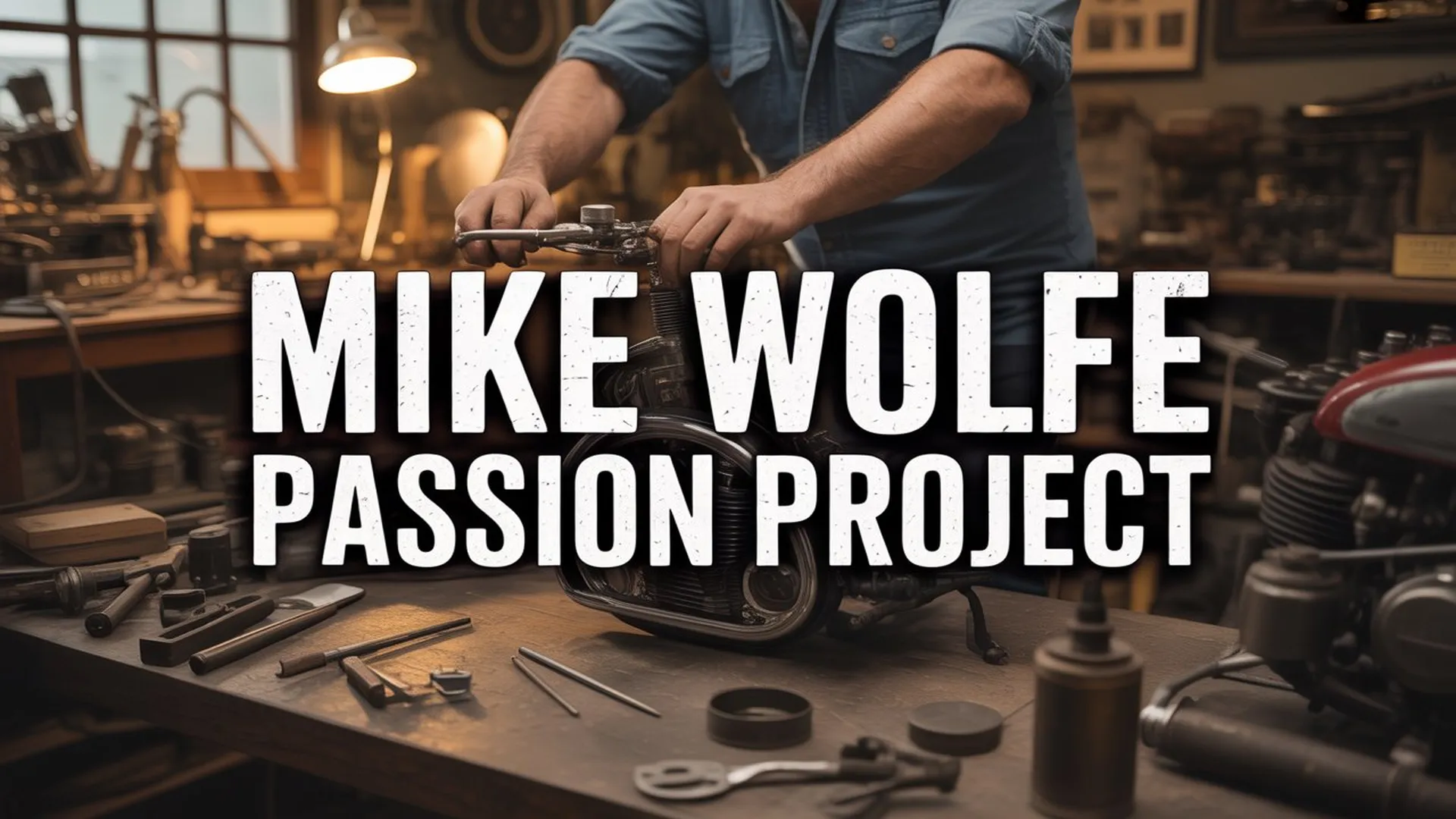Mike Wolfe passion project is not a TV storyline or a branding exercise, it’s a living mission to safeguard Americana through restoration, storytelling, and community-building that goes far beyond the success of American Pickers. His work restores historic places, uplifts craftspeople, and re-centers small towns as cultural anchors, turning forgotten buildings and artefacts into vibrant spaces and shared narratives that people can experience today and for generations to come.
From Collector to Cultural Steward
While most know him for trekking America’s backroads in search of rusted relics, Mike Wolfe’s deeper drive is preservation over possession, rescuing the history inside the items and the places where those stories were made. Over the years, the thrill of the hunt matured into a sustained focus on saving main streets, reviving heritage architecture, and investing in the people who keep traditional craftsmanship alive.
His evolution is clear: from “picker” to preservationist, he now directs time and resources toward cultural stewardship, community revitalization, and the narratives behind America’s built environment.
What Is the Mike Wolfe Passion Project?
At its heart, the Mike Wolfe passion project is an ongoing, multi-faceted initiative centered on:
- Restoring historic buildings in small towns to spark local pride and economic renewal.
- Turning overlooked sites into community hubs that draw residents and visitors together.
- Supporting artisans and heritage makers through platforms and partnerships that celebrate slow-made, purposeful goods.
- Documenting stories, people, places, trades, that embody the soul of Americana.
This work is purpose-driven, not profit-first, and designed to inspire others to see the beauty and value in preserving what’s real, durable, and rooted in place.
Signature Restorations and Community Impact
One of the clearest windows into his mission is the way he transforms neglected structures into gathering places and catalysts for neighborhood rebirth:
- Columbia, Tennessee – Wolfe purchased and restored an old Esso gas station in downtown Columbia, reimagining it as a public-facing space with outdoor seating, a fire pit, and lighting, with plans for a tenant-led concept called Revival offering food and cocktails. He described the goal as creating a space “generations of people can enjoy for years to come,” signaling his emphasis on long-term community value.
- Motor Alley and downtown revitalization – In and around Columbia, he has invested in multi-building restorations, embracing mixed-use potential while preserving original character, a model that blends historic integrity with modern utility.
- LeClaire, Iowa – As the home of Antique Archaeology, Wolfe has been part of revitalizing the riverfront downtown, using heritage-focused entrepreneurship to stimulate local tourism and small business activity.
These projects embody a consistent theme: preservation as placemaking, where architectural memory becomes an engine for community cohesion and economic energy.
The People Behind the Places
The Mike Wolfe passion project isn’t just about brick and timber; it’s about the people who give those structures meaning, tenants, neighbors, craftspeople, and visitors who engage with the spaces and keep them alive with new stories. He collaborates with local builders, designers, and preservation-minded teams who can match his commitment to quality and authenticity, as seen in Columbia where he credited partners for “bringing the place to life”.
This collaborative approach stabilizes projects long after the ribbon-cutting by aligning purpose with stewardship, tenants and teams who share an ethos of care, not just commercial occupancy.
Advocacy for Craftspeople and “Slow” Goods
Wolfe’s passion extends to craftspeople and makers who keep heritage trades relevant, leatherworkers, welders, restorers, and woodworkers creating practical beauty with integrity. Through platforms and partnerships, he elevates these makers and encourages communities to value hand-built, repairable goods over disposable trends. It’s a cultural stance: preservation isn’t only about buildings and objects, it’s about skills, values, and the dignity of work passed from one generation to the next.
Also Read- Asbestlint
Storytelling as Preservation
The most enduring element of the Mike Wolfe passion project may be storytelling itself, using media, photography, and documentation to keep memory active and accessible. American Pickers helped mainstream this idea, turning family sheds and barns into archives of lived experience, and inspiring viewers to explore their own histories and hometowns. Off-camera, Wolfe channels that same storytelling energy into advocacy and partnerships with historical societies, local governments, and preservation groups to champion what’s worth saving and why it matters now.
Why Small-Town America Matters
Small towns often hold America’s densest concentration of intact material culture, signs, stations, depots, machine shops, and storefronts that tell the story of mobility, trade, and community across the 20th century. Wolfe’s focus on towns in Tennessee and Iowa underscores a preservation truth: local identity is embedded in the built environment, and restoring it can catalyze pride, tourism, and entrepreneurship. Projects like the Columbia gas station show how modest-scale restorations can ripple outward, inviting residents to gather and visitors to linger.
Preservation Principles That Guide the Work
Across projects, several principles recur:
- Respect for original character: Maintain patina, proportions, and materials where feasible.
- Adaptive reuse: Reimagine function without erasing history, e.g., service stations reborn as social spaces.
- Local ecosystem building: Choose tenants and partners who align with community needs and heritage values.
- Public-facing purpose: Create places that invite gathering, not just private appreciation.
- Narrative continuity: Share the backstory so people understand and feel connected to the place.
These principles make preservation legible and lovable to the community, not just admirable in architectural terms.
What Sets This Mission Apart
Many preservation efforts fixate on museum-grade perfection; Wolfe’s approach embraces working heritage, spaces and objects that live, earn, host, and evolve. By grounding projects in active use and human stories, the work avoids becoming static or elitist and instead stays accessible and useful, especially in smaller communities where every new destination counts.
The Role of Media: From Screen to Street
American Pickers didn’t just entertain; it seeded a movement of amateur historians, collectors, and restorers who started seeing value where others saw clutter. That cultural shift laid the groundwork for broader appreciation of small-town main streets and roadside vernacular architecture. In turn, the Mike Wolfe passion project takes that energy offline, into deeds, permits, partnerships, and open doors, so the rediscovered past becomes part of everyday life.
Lessons for Anyone Who Wants to Start
Wolfe’s trajectory suggests a practical blueprint for preservation-minded creators, entrepreneurs, and municipalities:
- Start with one building, or even one room, and restore it with care for future use, not just display.
- Choose partners who amplify history rather than overwrite it: artisans, culinary teams, retailers, and community groups that speak the same language of place.
- Share the story relentlessly, on-site plaques, online posts, before/after documentation, so the public sees the value and roots for the project.
- Keep spaces flexible; community needs will evolve, and adaptable design keeps doors open through change.
- Tie the project to walkability and adjacent small businesses to maximize neighborhood impact.
These small decisions compound into cultural infrastructure, spaces that connect people to where they live and to each other.
The Emotional Core: Dignity, Memory, and Use
The emotional gravity of the Mike Wolfe passion project comes from its respect for everyday people, the machinists, line workers, station attendants, shopkeepers, whose labor animated the buildings now being restored. Keeping those places alive gives dignity to their memory and makes room for new stories to take root in the same soil. In doing so, Wolfe’s work subtly reframes progress: not as endless replacement, but as thoughtful continuity.
A Case Study in Columbia, Tennessee
The Columbia Esso station restoration captures this ethos in a single site: a defunct service station becomes a public gathering place with a fire pit and outdoor seating, and a tenant concept called Revival adds food and cocktails to the mix. The result is multigenerational hospitality in a historic shell, an invitation to linger, talk, and participate in the life of the street. The vision, as Wolfe framed it, was a space that “generations of people can enjoy for years to come,” a simple sentence that doubles as a mission statement for the broader project.
Also Read- Veganovies.com
Community as the True Client
Preservation succeeds when the community becomes the client, not just a developer, investor, or television audience. By relying on local partners, embracing adaptive reuse, and opening spaces for public enjoyment, the Mike Wolfe passion project aligns with the citizens who will use these places most. That alignment is why the work sticks: it is designed to be inhabited, not just admired.
The Future of the Mike Wolfe Passion Project
Looking ahead, expect continued focus on:
- Architectural rescue with sensitive adaptive reuse in small towns where a single rehabilitation can change a block’s trajectory.
- Partnerships that foster heritage hospitality, eateries, shops, and event spaces that respect original fabric while serving contemporary needs.
- Maker-centered ecosystems that keep traditional trades viable through exposure, patronage, and collaboration.
- Storytelling across platforms so more people recognize, visit, and support these spaces, and replicate the model in their communities.
Each new project acts as a proof point: preservation can be warm, useful, and economically smart when anchored in authenticity.
Why It Matters Now
As many towns wrestle with empty storefronts and generic redevelopment, the Mike Wolfe passion project demonstrates a different path, one that preserves identity while inviting growth. This approach helps communities avoid the cultural amnesia that can come with demolition or placeless construction. Instead, it lets the past pay dividends in tourism, entrepreneurship, and civic pride, returns that compound across years and generations.
How to Engage with the Mission
- Visit restored spaces and spend time, and money, there, helping show that heritage-driven places thrive when used.
- Support local craftspeople who repair, restore, and make, commission work, share their stories, and choose durable goods.
- Advocate for preservation-friendly zoning and incentives so adaptive reuse remains viable and attractive to owners.
- Treat your own family’s objects, photos, and buildings as a personal archive worth protecting and sharing with future generations.
These actions make preservation a participatory culture, not a spectator sport.
Closing: Preserving the Past to Inspire the Future
Mike Wolfe passion project is a reminder that preservation is ultimately about people, how they gather, remember, and create meaning in place. By restoring buildings, uplifting makers, and telling stories with care, Wolfe has shown that history isn’t a frozen exhibit but a living resource that strengthens communities when treated with respect. The spaces he revives, and the lives they touch, underscore a simple truth: when the past is honored, the future gets better roots.
In that spirit, the work continues, one storefront, one service station, one conversation at a time, inviting anyone who cares about authenticity to pick up a tool, lend a story, or simply take a seat by the fire pit in a once-forgotten station reborn for all to share.
Mike Wolfe passion project isn’t about nostalgia; it’s about purpose, continuity, and the enduring power of place to bring people together and keep America’s stories alive in the everyday.
FAQs: Mike Wolfe Passion Project
What is the “Mike Wolfe passion project”?
It’s an ongoing effort by the American Pickers star to preserve Americana through restoring historic buildings, supporting craftspeople, and turning overlooked places, like a vintage Esso gas station in Columbia, Tennessee, into lively community spaces.
What did he restore in Columbia, Tennessee?
He renovated an old Esso service station into a welcoming public gathering spot with outdoor seating, a fire pit, and lighting, with a tenant concept called Revival planned to offer food and cocktails.
Is the passion project part of Antique Archaeology?
No, it’s distinct from his retail brand and focuses on architectural preservation, placemaking, and community revitalization rather than merchandise sales.
How does the project benefit local communities?
By preserving character-rich buildings, attracting visitors, and creating hubs for small businesses and cultural activity, which can spur local pride and economic momentum.
How can people support or get involved?
Visit restored spaces, follow progress and announcements, share local history or leads, and support heritage makers and small businesses connected to these revitalized places.




